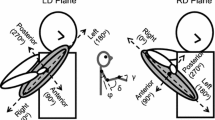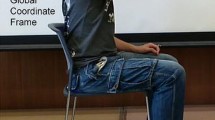Abstract
This study tested the validity of the assumption that intrinsic kinematic constraints, such as Listing’s law, can account for the geometric features of three-dimensional arm movements. In principle, if the arm joints follow a Listing’s constraint, the hand paths may be predicted. Four individuals performed ‘extended arm’, ‘radial’, ‘frontal plane’, and ‘random mixed’ movements to visual targets to test Listing’s law assumption. Three-dimensional rotation vectors of the upper arm and forearm were calculated from three-dimensional marker data. Data fitting techniques were used to test Donders’ and Listing’s laws. The coefficient values obtained from fitting rotation vectors to the surfaces described by a second-order equation were analyzed. The results showed that the coefficients that represent curvature and twist of the surfaces were often not significantly different from zero, particularly not during randomly mixed and extended arm movements. These coefficients for forearm rotations were larger compared to those for the upper arm segment rotations. The mean thickness of the rotation surfaces ranged between ≈1.7° and 4.7° for the rotation vectors of the upper arm segment and ≈2.6° and 7.5° for those of the forearm. During frontal plane movements, forearm rotations showed large twist scores while upper arm segment rotations showed large curvatures, although the thickness of the surfaces remained low. The curvatures, but not the thicknesses of the surfaces, were larger for large versus small amplitude radial movements. In conclusion, when examining the surfaces obtained for the different movement types, the rotation vectors may lie within manifolds that are anywhere between curved or twisted manifolds. However, a two-dimensional thick surface may roughly represent a global arm constraint. Our findings suggest that Listing’s law is implemented for some types of arm movement, such as pointing to targets with the extended arm and during radial reaching movements.






Similar content being viewed by others
References
Admiraal MA, Medendorp WP, Gielen CCAM (2001) Three-dimensional head and upper arm orientations during kinematically redundant movements and at rest. Exp Brain Res 142:181–192
Bernstein N (1967) The coordination and regulation of movements. Pergamon Press, Oxford
Ceylan M, Henriques DYP, Tweed DB, Crawford JD (2000) Task-dependent constraints in motor control: pinhole goggles make the head move like an eye. J Neurosci 20:2719–2730
Crawford JD, Vilis T (1995) How do motor systems deal with the problems of controlling three-dimensional rotations? J Mot Behav 27:89–99
DeSouza JFX, Nicolle DA, Vilis T (1997) Task-dependent changes in the shape and thickness of Listing’s plane. Vision Res 37:2271–2282
Donders FC (1847) Beitrag zur Lehre von den Bewegungen des menschlichen Auges. Holländ Beitr Anat Physiol Wiss 1:104–145
Gielen CCAM, Vrijenhoek EJ, Flash T, Neggers SFW (1997) Arm position constraints during pointing and reaching in 3D. J Neurophysiol 78:1179–1196
Glenn B, Vilis T (1992) Violations of Listing’s law after large eye and head gaze shifts. J Neurophysiol 68:309–318
Haslwanter T (1995) Mathematics of 3-dimensional eye rotations. Vision Res 35:1727–1739
Hepp K (1990) On Listing’s law. Commun Math Phys 132:285–292
Hollerbach JM, Flash T (1982) Dynamic interactions between limb segments during planar arm movement. Biol Cybern 44:67–77
Hore J, Watts S, Vilis T (1992) Constraints on arm position when pointing in three dimensions: Donders’ law and the Fick-gimbal strategy. J Neurophysiol 68:374–383
Marotta JJ, Medendorp WP, Crawford JD (2003) Kinematic rules for upper and lower arm contributions to grasp orientation. J Neurophysiol 90:3816–3827
Medendorp WP, Van Gisbergen JAM, Horstink MWIM, Gielen CCAM (1999) Donders’ law in Torticollis. J Neurophysiol 82:2833–2838
Medendorp WP, Crawford JD, Henriques DYP, Van Gisbergen JAM, Gielen CCAM (2000) Kinematic strategies for upper arm–forearm coordination in three dimensions. J Neurophysiol 84:2302–2816
Miller LE, Theeuwen M, Gielen CCAM (1992) The control of arm pointing movements in three dimensions. Exp Brain Res 90:415–426
Mitra S, Turvey MT (2004) A rotation invariant in 3-D reaching. J Exp Psychol Hum Percept Perform 30:163–169
Morasso P (1981) Spatial control of arm movements. Exp Brain Res 42:223–227
Van Opstal J (1993) Representation of eye position in three dimensions. In: Berthoz A (ed) Multi-sensory control of movement. Oxford University Press, Oxford, pp 27–41
Soechting JF, Buneo CA, Herrmann U, Flanders M (1995) Moving effortlessly on three dimensions: does Donders’ law apply to arm movements? J Neurosci 15:6271–6280
Straumann D, Haslwanter T, Hepp-Reymond MC, Hepp K (1991) Listing’s law for the eye, head and arm movements and their synergistic control. Exp Brain Res 86:209–215
Theeuwen M, Miller LE, Gielen CCAM (1993) Are the orientations of the head and arm related during pointing movements? J Mot Behav 25:242–250
Tweed D (1999) Three-dimensional model of the human eye–head saccadic system. J Neurophysiol 77:654–666
Tweed D, Vilis T (1987) Implications of rotational kinematics for the oculomotor systems in three dimensions. J Neurophysiol 58:832–849
Tweed D, Vilis T (1990) Geometric relations of eye position and velocity vectors during saccades. Vision Res 30:111–127
Westheimer G (1957) Kinematics of the eye. J Optic Soc Am 47:967–974
Acknowledgments
We gratefully acknowledge the help of Dr. L. Zuk from the University of Tel Aviv and the support of Mrs. E. Nuri. The research was supported in part by the Israeli Ministry of Science and by the Moross Vision and Robotics Laboratory, Weizmann Institute of Science, Israel. Tamar Flash is an incumbent of the Dr. Hymie Moross Professorial Chair.
Author information
Authors and Affiliations
Corresponding author
Rights and permissions
About this article
Cite this article
Liebermann, D.G., Biess, A., Friedman, J. et al. Intrinsic joint kinematic planning. I: Reassessing the Listing’s law constraint in the control of three-dimensional arm movements. Exp Brain Res 171, 139–154 (2006). https://doi.org/10.1007/s00221-005-0265-x
Received:
Accepted:
Published:
Issue Date:
DOI: https://doi.org/10.1007/s00221-005-0265-x




